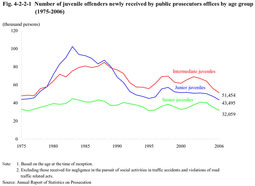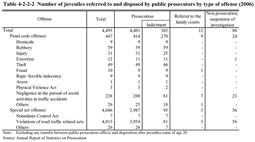| Previous Next Index Image Index Year Selection | |
|
|
1 Disposition by public prosecutors offices
(1) Cases received
The total number of juvenile offenders newly received by public prosecutors offices in 2006 was 197,641 (the juvenile rate: 9.6%). Those for penal code offenses were 156,056 (12.6% (id.)), among which 122,967 (32.8% (id.)) were for non-traffic penal code offenses. Those for special act offenses were 41,585 (5.0% (id.)), among which 4,041 (3.4% (id.)) were for special act offenses excluding violations of road traffic related acts (Source: Annual Report of Statistics on Prosecution). Fig. 4-2-2-1 shows the number of juvenile offenders aged 14-19 newly received by public prosecutors offices (excluding those for negligence in the pursuit of social activities in traffic accidents and violations of road traffic related acts) since 1975, by age group. The number of junior juveniles had been larger than that of other age groups since 1979, but intermediate juveniles have been the largest in number after surpassing junior juveniles in 1990. Fig. 4-2-2-1 Number of juvenile offenders newly received by public prosecutors offices by age group (1975-2006) Looking at the age group distribution of juvenile offenders newly received by public prosecutors offices in 2006 by type major offense, the junior juveniles formed a high percentage for injury, the intermediate and senior juveniles formed a high percentage for robbery, the intermediate juveniles formed a high percentage for homicide, extortion, theft and arson, and the senior juveniles formed a high percentage for rape/forcible indecency, negligence in the pursuit of social activities in traffic accidents, violations of road traffic related acts, and Stimulant Control Act violations (see Appendix 4-8).(2) Referral to family courts A public prosecutor can attach his/her opinion regarding the treatment of the juvenile when he/she refers a juvenile case to a family court (see Appendix 4-9 for public prosecutors' opinions about juvenile treatments for criminal disposition, commitment to juvenile training schools and probationary supervision). (3) Disposition of cases referred by family courts Table 4-2-2-2 shows the number of juveniles disposed by public prosecutors for those referred to public prosecutors by family courts in 2006, by type of offense. The percentage of those who were brought to indictment to the total prosecuted juveniles in 2006 was rather low at 8.3%. This was because the percentage of those who were brought to indictment was extremely low at 2.0% among those prosecuted for violations of road traffic related acts, which accounted for nearly 90% of the total prosecuted juveniles. The percentage of those who were brought to indictment for offenses other than violations of road traffic related acts was 63.5% to the total, and 65.2% to the total penal code offenders and 42.4% to the total special act offenders. Table 4-2-2-2 Number of juveniles referred to and disposed by public prosecutors by type of offense (2006) |

